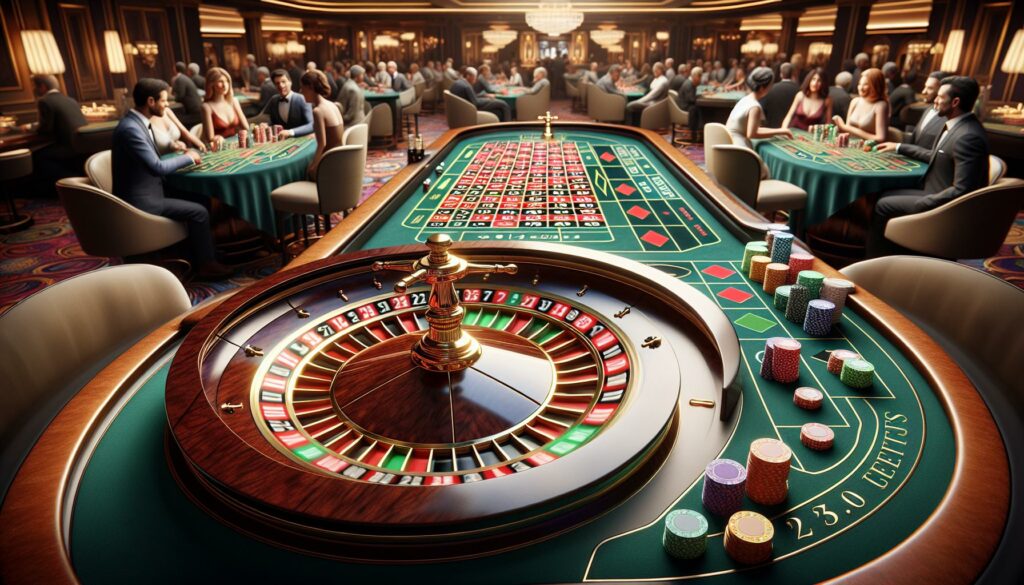European roulette is one of the most popular casino games around the world, and for good reason. With its elegant design and thrilling gameplay, it’s easy to see why players are drawn to the spinning wheel and the anticipation of where the ball will land. I find the simplicity of the game captivating, making it accessible for both beginners and seasoned players alike. Unlike its American counterpart, European roulette features a single zero, which significantly alters the odds in favor of the player. This subtle difference can impact your strategy and overall experience. Whether you’re playing in a lavish casino or online, understanding the nuances of European roulette can enhance your enjoyment and possibly boost your winnings. Let’s dive deeper into the fascinating world of this classic game and explore what makes it so enticing.
- European roulette features 37 numbered pockets (0-36), offering a single zero that reduces the house edge to 2.7%, making it more favorable compared to American roulette.
- The game provides a variety of betting options, including inside bets (higher risk, higher payouts) and outside bets (lower risk, lower payouts), allowing players to customize their strategies.
- Understanding common betting strategies like Martingale, Reverse Martingale, and D’Alembert can enhance gameplay and potentially maximize winnings.
- It’s essential for players to familiarize themselves with the rules and options, setting a budget and practicing with free versions to build confidence before wagering real money.
- The distinct layout of the European roulette wheel and table influences betting strategies and outcomes, adding depth to the overall gaming experience.
What is European Roulette
European roulette is a popular casino game known for its simplicity and elegance. It features a wheel with 37 numbered pockets, ranging from 0 to 36. The absence of a double zero, common in American roulette, lowers the house edge to 2.7%. This single zero provides players with better odds and creates various betting options.
Players make bets on different outcomes, such as specific numbers, color choices, or high/low groupings. The game is typically played on a table that displays the layout, which helps in placing bets confidently.
When the wheel spins, a ball is dropped into the pockets. As the ball comes to rest, the winning number is determined, and appropriate payouts are made based on the bets placed. The straightforward rules and potential for substantial winnings make European roulette a favorite among both novice and skilled players.
Game Overview
European roulette offers a thrilling experience with straightforward rules and diverse betting options. Understanding its mechanics enhances gameplay and increases winning potential.
Basic Rules
Players start by placing their bets on the table layout, selecting from various options such as individual numbers or groups like colors and ranges. Once bets are placed, the dealer spins the wheel and releases the ball. The game concludes when the ball settles into one of the 37 pockets, with payouts determined based on the winning number or bet type. Players can adjust their strategies according to the available bets, which include outside bets (like red/black or odd/even) and inside bets (specific numbers or combinations). The single zero pocket differentiates European roulette, providing a 2.7% house edge, which offers slightly better odds for players compared to American roulette.
Wheel Structure
The European roulette wheel consists of 37 distinct pockets numbered from 0 to 36. The layout is designed to create an unpredictable outcome, contributing to the game’s excitement. The single zero (0) pocket is green, while the remaining numbers alternate in black and red. This structure influences betting strategies, as players must consider the odds associated with each number or color. Additionally, the arrangement of numbers on the wheel differs from the layout on the betting table, adding a layer of complexity that experienced players may leverage for strategic bets.
Betting Options
European roulette offers various betting options that enhance the game’s appeal and complexity. Players can choose between inside and outside bets to create diverse strategies and possibilities for winning.
Inside Bets
Inside bets involve placing chips directly on specific numbers or small groups of numbers on the table layout. These bets provide higher payouts due to their lower probability of winning. Common inside bets include:
- Straight Bet: A bet placed on a single number, including zero. The payout is 35 to 1.
- Split Bet: A bet on two adjacent numbers by placing chips on the line that separates them. The payout is 17 to 1.
- Street Bet: A bet on three consecutive numbers in a horizontal line. The payout is 11 to 1.
- Corner Bet: A bet on a group of four numbers by placing chips at the intersection of their corner. The payout is 8 to 1.
- Line Bet: A bet on two rows of three numbers each. The payout is 5 to 1.
Outside Bets
Outside bets cover broader categories and provide a higher chance of winning, albeit with lower payouts. These bets are placed outside the main number grid and include:
- Red/Black: A bet on either all red or all black numbers, excluding zero. The payout is 1 to 1.
- Even/Odd: A bet on all even or all odd numbers. The payout is 1 to 1.
- High/Low: A bet on numbers 1-18 (low) or 19-36 (high). The payout is 1 to 1.
- Dozen Bets: A bet placed on one of the three dozens (1-12, 13-24, or 25-36). The payout is 2 to 1.
- Column Bet: A bet on one of the three vertical columns of numbers on the layout. The payout is 2 to 1.
These varied betting options allow players to customize their approach for each spin, enhancing the excitement and strategy inherent in European roulette.
House Edge and Payouts
Understanding the house edge and payouts is crucial for any player in European roulette. The house edge in European roulette stands at 2.7%, courtesy of the single zero on the wheel. This edge means that, on average, players can expect to lose 2.7% of their total bets over time, making it more favorable than American roulette, which features a house edge of 5.26%.
Payouts in European roulette vary based on the type of bet placed. The following table outlines common bets and their corresponding payouts:
| Bet Type | Description | Payout |
|---|---|---|
| Straight Bet | Bet on a single number | 35 to 1 |
| Split Bet | Bet on two adjacent numbers | 17 to 1 |
| Street Bet | Bet on three consecutive numbers | 11 to 1 |
| Corner Bet | Bet on four numbers forming a square | 8 to 1 |
| Line Bet | Bet on six consecutive numbers | 5 to 1 |
| Red/Black | Bet on the color of the winning number | 1 to 1 |
| Odd/Even | Bet on whether the winning number is odd or even | 1 to 1 |
| High/Low | Bet on whether the number is in the higher or lower range (19-36 or 1-18) | 1 to 1 |
| Dozen Bet | Bet on one of three sets of twelve numbers | 2 to 1 |
| Column Bet | Bet on one of the three vertical columns | 2 to 1 |
These payouts reflect the probability of winning for each bet type. Higher payouts typically accompany lower probabilities, while lower payouts align with higher winning chances. Players must adjust their strategies based on their risk tolerance and desired payouts, balancing between conservative and aggressive betting approaches.
Strategies for Playing
Mastering European roulette involves understanding various strategies that enhance gameplay. I recommend exploring common strategies and tips tailored for beginners.
Common Strategies
- Martingale Strategy
I double my bets after each loss, aiming to recover previous losses with one win. This strategy requires a substantial bankroll and awareness of table limits. - Reverse Martingale Strategy
I increase my bets after each win, maximizing profits during winning streaks. When I lose, I revert to my initial bet, protecting my bankroll. - D’Alembert Strategy
I adjust my bets based on wins and losses, increasing my bet by one unit after a loss and decreasing by one after a win. This method balances risk and reward over time. - Fibonacci Strategy
I follow a sequence where each bet equals the sum of the two preceding bets after a loss. This progressive betting system allows for gradual risk management. - Flat Betting Strategy
I consistently wager the same amount on each spin, reducing the risk of substantial losses. This conservative approach helps sustain my bankroll longer. - Start Small
I place low-risk bets while familiarizing myself with the game. This cautious approach minimizes losses as I learn. - Understand the Rules
I thoroughly read the game rules and betting options. Knowledge of the layout and game mechanics enhances my decision-making. - Set a Budget
I establish a clear budget before playing, ensuring I only gamble what I can afford to lose. Sticking to my budget keeps my gaming experience enjoyable. - Practice with Free Games
I take advantage of free online versions of European roulette. Practicing without financial risk helps build my confidence and skills. - Avoid Chasing Losses
I remain disciplined and avoid increasing my bets impulsively after losses. Staying calm and strategic leads to better long-term results.
European roulette stands out as a thrilling and elegant game that captures the attention of both new and seasoned players. Its unique single zero and diverse betting options create an engaging atmosphere that enhances the overall experience.
Understanding the mechanics and strategies can significantly improve your gameplay while keeping it exciting. Whether you prefer the thrill of inside bets or the safer approach of outside bets, there’s something for everyone.
As you explore European roulette, remember to play responsibly and enjoy the journey. Each spin holds the promise of excitement and the chance to refine your strategies. Happy spinning!

